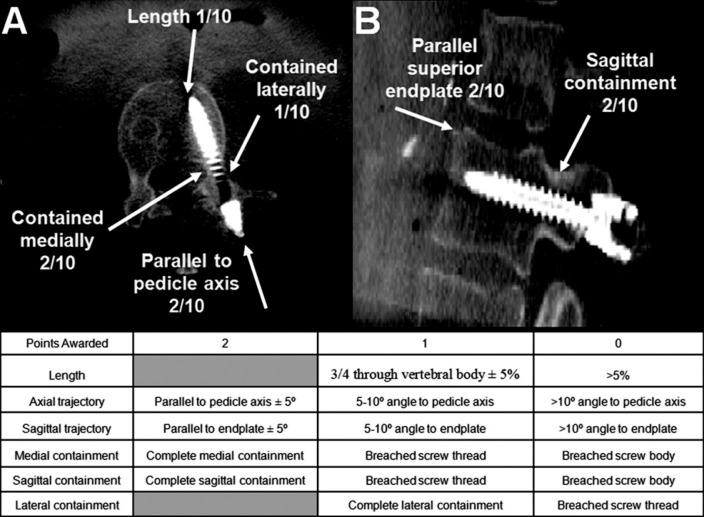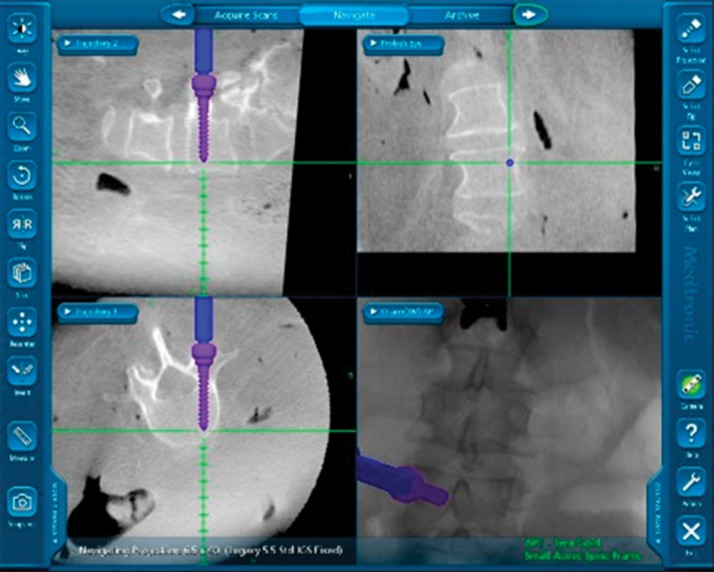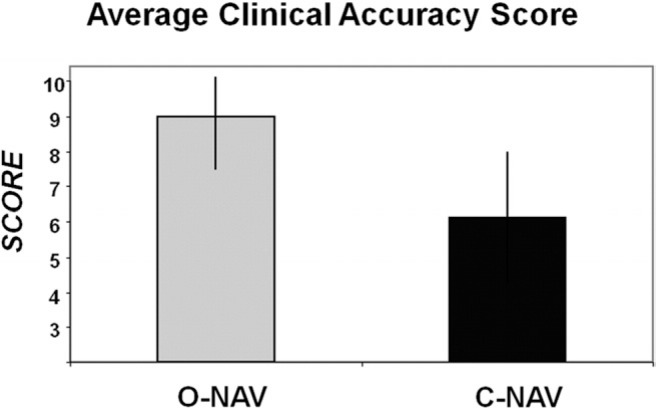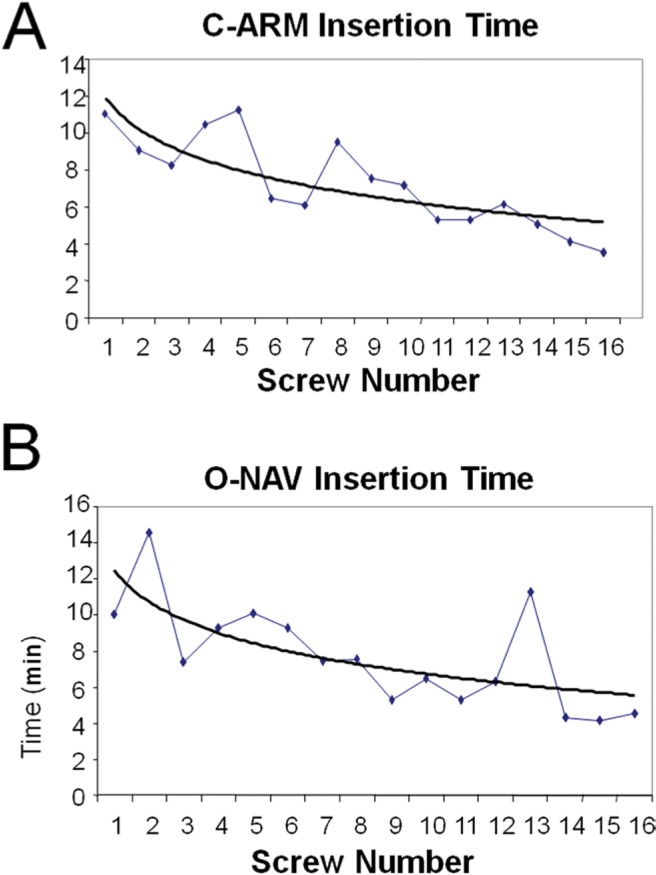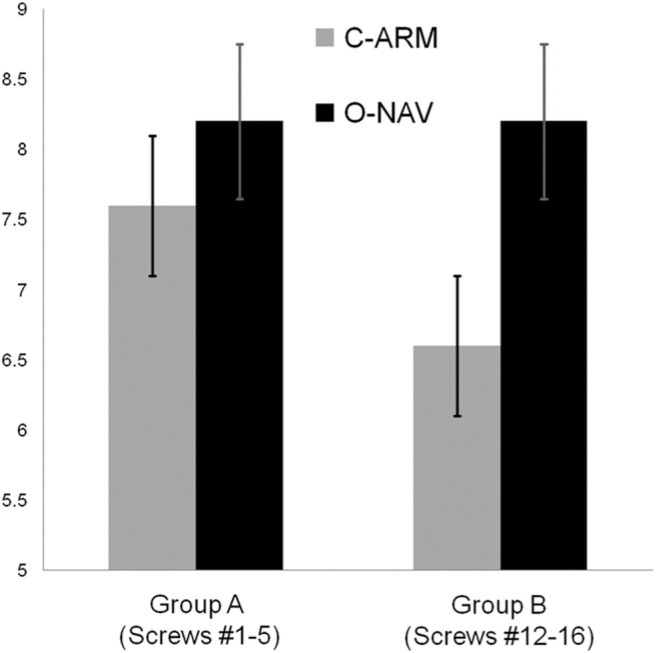Abstract
Background
A quantitative screw accuracy system is proposed that allows for high-fidelity discrimination between various methods of pedicle screw insertion. Our purpose was to study the utility of a quantitative screw accuracy scoring system to assess new imaging technologies and their effects on the minimally invasive spine learning curve.
Methods
By use of a hypothetical “perfect screw,” a scoring system is proposed that may be used to compare the position of a small number of screws inserted according to a desired optimal position. This study incorporates a retrospective review of imaging studies for 10 patients who underwent percutaneous pedicle screw placement with either navigation-assisted O-arm imaging or navigation-assisted C-arm imaging. For the learning-curve portion of the study, 2 cadaveric adult torsos were used for instrumentation. Computed tomography imaging studies were used in both studies to assess screw position in the pedicle and vertebral body in relation to an optimal screw by use of a quantitative scoring system to rate accuracy.
Results
The quantitative scoring system allowed a statistically significant accuracy difference to be ascertained between 2 different technologies using fewer data points than previously published methods. When this screw scoring system is applied to minimally invasive percutaneous pedicle screw insertion, an optimal screw position can be achieved with greater accuracy through navigation-assisted technology (O-arm with computer-assisted navigation). When the O-arm with computer-assisted navigation was used by a novice surgeon learning the technique of percutaneous screw insertion, screws were inserted in a shorter period without loss of accuracy. In contrast, use of the traditional C-arm fluoroscopy leads to a loss of accuracy with faster insertion times. Increased accuracy can be seen clinically when compared with fluoroscopic navigation.
Conclusions
The use of a quantitative scoring system allows for rapid assessment of screw accuracy. As additional technologies and new teaching techniques for pedicle screw insertion are developed, this scoring system may be useful as an early assessment tool.
Keywords: Navigation, Image guidance, Minimally invasive surgery, Spinal instrumentation, Scoring system
The use of instrumentation to surgically correct spinal deformities has evolved dramatically from the first recorded case of internal spinal instrumentation in 1891.1 Pedicle screw instrumentation was developed in 1984 and was a great improvement over the previously used wire-and-hook method to stabilize the spine.2 More recent advancements in pedicle screw technology include minimally invasive, percutaneous pedicle screw systems.3 Whereas minimally invasive spine (MIS) surgery has been shown to significantly reduce postoperative pain and allow for quicker recovery,4 its adoption has been hampered by the technical difficulty of the procedure and its inherently difficult learning curve.4–6
One of the major challenges of MIS surgery is the insertion of pedicle screws in a percutaneous fashion using intraoperative imaging rather than direct anatomic visualization. As a result, pedicle screws must be inserted through a relatively small channel of bone that is immediately adjacent to exiting nerve roots. A malpositioned screw has the potential to injure these nearby nerves. Furthermore, fixation strength of the biomechanical construct may be adversely affected by malpositioned hardware. Given these issues, the importance of a rapid and reproducible method of evaluating pedicle screw accuracy becomes paramount.
Previous methods to assess pedicle screw accuracy have been inconsistent and relatively insensitive. In most series hundreds if not thousands of screws were required to reach statistically significant conclusions.7–19 Therefore we have developed a graded numeric scoring system that compares the 3-dimensional (3D) position of a given pedicle screw relative to an ideal, “perfect” screw. In this study we determined whether our novel scoring system is a practical method to rapidly assess new technology through its application in the evaluation of 2 aspects of minimally invasive surgery: the accuracy of minimally invasive pedicle screw insertion using a new imaging technology, O-arm with computer-assisted navigation (O-NAV), and the effect of this new imaging technology on the MIS learning curve.
Methods
Evaluation of accuracy using a quantitative screw accuracy scoring system
The accuracy of percutaneously inserted pedicle screws was assessed postoperatively by use of high-resolution spiral computed tomography imaging with 1-mm cuts. Screw placement was scored on 6 graded parameters: screw length; axial and sagittal trajectory; and medial, superior, inferior, and lateral breaches (Fig. 1). Ten possible points were given for each pedicle screw. A score of 10 was given for an ideal screw that had the following characteristics: (1) screw length equivalent to three-fourths the length of the vertebral body; (2) screw trajectory within 5° of the axis of the pedicle; (3) placement parallel to the superior endplate in the sagittal plane; (4) absence of inferior and/or superior breaches; (5) absence of medial breaches; and (6) absence of cortical breaches. Each screw was then scored with respect to these parameters as detailed in Fig. 2.
Fig. 1.
Parameters of screw accuracy scoring system. Axial computed tomography scan showing parameters of length, medial and lateral containment, and trajectory (A). Sagittal computed tomography scan showing sagittal containment and sagittal trajectory parameters (B). The clinically relevant parameters (medial and lateral containment, axial trajectory) are weighted for greater impact on the scoring scheme.
Fig. 2.
Screen shot image of O-NAV monitor. The 3D imaging capabilities of O-NAV allow the surgeon increased visualization of the operative field. Up to 4 navigated images can be viewed at once when using O-NAV. The image configuration can be customized to the surgeon's preference.
O-NAV technique
A navigation reference pin—a 5-mm fluted pin (Navigation Perc Pin; Medtronic Navigation, Louisville, Colorado)—was placed into the posterior superior iliac spine (PSIS). Images of the spine were obtained by the O-arm and stored in the navigation system computer. These acquired images were related to the patient reference pin and navigated instruments in 3D space by the navigation computer. The O-arm was removed from the operative field once the desired images were obtained. Up to 4 navigated images could be seen at once on the O-NAV screen during pedicle screw insertion (Fig. 2). The navigation pointer was used to plan the incision. A 1.5-cm skin incision was made, and the dorsal fascia was incised. The pedicle was entered by use of a navigated Jamshidi needle (Medtronic Navigation, Louisville, Colorado) ensuring proper 3D direction of the pedicle screw. The needle was exchanged for a Kirschner guidewire. The pedicle was then tapped by use of a hand drill to allow a port for screw entry. Finally, an appropriately sized pedicle screw was inserted with a navigated screwdriver.
Technique for C-arm imaging with computer-assisted navigation
Pedicle screws were placed by the technique described previously except that C-arm imaging with computer-assisted navigation was used instead of O-arm imaging. A detailed description of this technique was previously described.8
Clinical accuracy evaluation
The accuracy of percutaneous pedicle screws inserted by O-NAV was compared with the accuracy of screws placed with the C-arm with computer-assisted navigation (C-NAV). A single surgeon (C.W.K.) inserted 22 percutaneous pedicle screws in 4 patients using O-NAV. By use of O-NAV, 8 screws were placed at L5, 8 at L4, and 6 at L3. In the next series of 6 consecutive patients, 24 pedicle screws inserted by C-NAV were graded for comparison to the O-NAV group. Of the screws inserted by C-NAV, 9 were placed at L5, 9 at L4, and 6 at L3. Screws in S1 were not assessed. Accuracy was assessed postoperatively as described previously. C-NAV screws were matched by insertion level to O-NAV screws to reduce confounding variables. All C-NAV and O-NAV screws were inserted by the same surgeon (C.W.K.), who has several years of experience performing C-NAV procedures but limited experience in percutaneous pedicle screw insertion using O-NAV.
Cadaveric learning-curve study
To assess the learning curve of percutaneous pedicle screw insertion, a separate cadaveric study was performed. Adult cadavers were thawed and appropriately positioned on a radiolucent table. Pedicle screws were inserted with either C-arm fluoroscopy (C-NAV group) or the navigation-assisted O-arm technique as described previously (O-NAV). A single novice spine surgery fellow (G.J.R.) performed 32 percutaneous pedicle screw insertions on 2 cadavers from T10 to L5. A randomized insertion scheme, where screws were inserted in a nonlinear progression of vertebral levels, was generated a priori to control for bias. To further control for anatomic variance, the surgeon inserted screws in a “zigzag” pattern so that each sequential screw was placed in the contralateral pedicle. All O-NAV screws were sequentially placed according to this predetermined algorithm. After taking a short break, the surgeon then proceeded to insert all C-NAV screws following the same progression. The spine fellow had no previous experience inserting percutaneous pedicle screws with O-NAV and limited experience inserting screws with C-NAV. A total of 16 pedicle screws were inserted by C-arm fluoroscopy, and 16 pedicle screws were inserted by O-NAV. The learning curve was evaluated based on total time required to insert each pedicle screw and accuracy of screw placement as a function of chronologic screw insertion number.
Statistical analysis
Data collected for comparison of accuracy between O-NAV and C-NAV were statistically analyzed by use of a 1-way analysis of variance and Fisher's comparison t test with α = .05.
Results
Use of scoring system in clinical practice
Percutaneous pedicle screws inserted by O-NAV were found to have a significantly higher mean accuracy score than those inserted by C-NAV (P = .0001) (Fig. 3). The mean pedicle screw accuracy score by O-NAV was 9.00 ± 1.51. Pedicle screws inserted by C-NAV resulted in a mean accuracy score of 6.13 ± 1.85. In the O-NAV group, 50% of implanted screws received a grade of 10 of 10, whereas only 4% of screws in the C-NAV group received a grade of 10 of 10 (P = .0005). This level of statistical significance was ascertained by assessment of only 46 total pedicle screws.
Fig. 3.
Clinical quantitative screw accuracy scores comparing O-NAV and C-NAV.
Cadaveric learning-curve study
A cadaveric model was used to assess the learning curve of percutaneous pedicle screw insertion. A novice spine surgeon was assessed for screw insertion times and screw placement accuracy using either the traditional C-NAV technique or O-NAV technique.
Insertion times decreased with chronologic screw number. After the eighth screw, the total procedure time stabilized at a value of approximately 6 minutes (Fig. 4). However, screw accuracy decreased with further insertion when the C-arm was used. No loss of screw accuracy was observed when the O-arm was used. The mean accuracies of the initial 5 screws inserted and the final 5 screws inserted were compared for each technique by use of our graded, quantitative scale. With the C-arm, screws 1 through 5 had a mean accuracy score of 7.6 and a mean insertion time of 10.25 minutes whereas screws 12 through 16 had a mean accuracy score of 6.6 and a mean insertion time of 4.67 minutes. With O-NAV, screws 1 through 5 had a mean accuracy score of 8.2 and a mean insertion time of 11.06 minutes whereas screws 12 through 16 had a mean accuracy of 8.2 and a mean insertion time of 4.73 minutes. The higher accuracy score for the final 5 graded screws inserted by O-NAV as compared with the final 5 screws for C-arm was statistically significant (P = .05) (Fig. 5). These data show that the accuracy score is adversely affected as pedicle screws are inserted more rapidly by use of C-arm imaging whereas placement accuracy is not affected by more rapid insertion of screws by O-NAV.
Fig. 4.
Scores from cadaveric learning-curve study. Mean insertion time in minutes with traditional C-arm technique (A). Mean insertion time in minutes with O-NAV technique (B).
Fig. 5.
Mean accuracy score from cadaveric learning-curve study. The initial 5 screws (1–5) and final 5 screws (12–16) inserted for each technique (O-NAV and C-NAV) are plotted.
Discussion
Although several grading systems for pedicle screw accuracy exist, they lack sufficient sensitivity to allow rapid assessment of new technologies. The importance of this issue is illustrated in the relatively slow adoption of MIS pedicle screw insertion. In the current state of MIS surgery, the key obstacle to adoption remains the difficult learning curve.20 In most studies several hundred screws to thousands of screws were examined to obtain a statistically meaningful assessment of screw placement accuracy. Previous studies have compared the accuracy of pedicle screw placement between 2 technical modalities, both with open procedures and with minimally invasive procedures, through application of various scoring systems to postoperative computed tomography images.7–19 These studies evaluate accuracy by recording the presence or absence of a cortical breach or through grading in terms of breach severity. Assessment of so few parameters of relative infrequency results in an insensitive method of evaluation. As a result, large sample sizes have been required to discern the difference in screw accuracy between techniques. A recent study by Parker et al15 evaluated the accuracy of insertion of 6,816 pedicle screws by a freehand technique. They used a scoring system whose single parameter was absence or presence of a cortical breach. Another study, conducted by Devito et al,17 attempted to increase the sensitivity of accuracy assessment through discrimination of breach severity based on increasing 2-mm increments of screw protrusion outside the pedicle. This study used 3,271 pedicle screws for evaluation.
There is a need to assess accuracy more quickly in the clinical setting so that an undue number of patients are not exposed to unnecessary risk. Therefore we have developed a numeric, graded scoring system that compares the 3D position of a given pedicle screw relative to an ideal, “perfect” screw.
This quantitative accuracy scoring system allows for rapid discrimination of techniques using a small number of data points when used to assess pedicle screw accuracy and physician learning curve by use of O-NAV technology. We recognized a statistically significant difference in screw accuracy and a noticeable trend in learning curves with much smaller sample sizes as compared with previous methods of evaluation. In the clinical setting, navigation-assisted O-arm imaging (O-NAV) results in more accurate percutaneous pedicle screw placement than navigation-assisted C-arm imaging (C-NAV). Only 46 screws were necessary to show that O-NAV yielded higher overall accuracy scores than C-NAV, as well as significantly higher scores in clinically relevant subcategories of accuracy scoring.
On the basis of these observations, we sought to determine whether the O-NAV technology could decrease the learning curve associated with percutaneous pedicle screw insertion. Using a cadaveric model, a novice spine surgeon was tested on percutaneous pedicle screw insertion using standard C-arm imaging or O-NAV. Both imaging technologies produced a trend toward faster screw insertion times as a function of screw number. However, the screw accuracy score suffered with faster insertion times when the C-arm was used. In contrast, screw accuracy did not suffer with faster insertion times when the O-NAV technique was used. These results were obtained from analysis of only 32 total pedicle screws with the proposed scoring system.
The incorporation of multiple parameters, such as screw position in 3D space, in addition to cortical breaches, makes our proposed scoring system a more sensitive tool in accuracy evaluation than currently available methods. Further-more, this scoring system is able to evaluate clinically important subcategories of screw position, such as medial and superior breaches, in addition to overall accuracy in 3D space. More weight was placed on medial and sagittal containment within the pedicle in an attempt to correlate a higher accuracy score to a more favorable clinical outcome. This clinical study was completed to showcase the ability of a novel quantitative scoring system to be a simple, consistent method to discriminate accuracy using a small sample size.
Conclusions
A quantitative screw accuracy scoring is described based on the concept of the ideal pedicle screw. By use of a numeric scoring system ranging from 1 to 10, screw insertion techniques can be compared with high fidelity, decreasing the number of screws requiring testing. This minimizes undue risk to patients when applying new technologies for MIS pedicle screw insertion. This may be particularly useful to assess the learning curve of minimally invasive percutaneous pedicle screw insertion via advanced intraoperative imaging technology.
References
- 1.Samartzis D, Shen FH, Perez-Cruet MJ, Anderson DG. Minimally invasive spine surgery: a historical perspective. Orthop Clin North Am. 2007;38:305–26. doi: 10.1016/j.ocl.2007.04.006. abstract v. [DOI] [PubMed] [Google Scholar]
- 2.Cotrel Y, Dubousset J. A new technic for segmental spinal osteosyn-thesis using the posterior approach [in French] Rev Chir Orthop Reparatrice Appar Mot. 1984;70:489–94. [PubMed] [Google Scholar]
- 3.Hubbe U, Kogias E, Vougioukas VI. Image guided percutaneous trans-pedicular screw fixation of the thoracic spine. A clinical evaluation. Acta Neurochir (Wien) 2009;151:545–9. doi: 10.1007/s00701-009-0272-y. discussion 549. [DOI] [PubMed] [Google Scholar]
- 4.Peng CW, Yue WM, Poh SY, Yeo W, Tan SB. Clinical and radiological outcomes of minimally invasive versus open transforaminal lumbar interbody fusion. Spine (Phila Pa 1976) 2009;34:1385–9. doi: 10.1097/BRS.0b013e3181a4e3be. [DOI] [PubMed] [Google Scholar]
- 5.Fessler RG. Minimally invasive spine surgery. Neurosurgery. 2002;51:Siii–iv. doi: 10.1097/00006123-200211002-00001. [DOI] [PubMed] [Google Scholar]
- 6.Webb J, Gottschalk L, Lee Y, Garfin S, Kim C. Surgeon perceptions of minimally invasive spine surgery. SAS J. 2008;2:62–6. doi: 10.1016/SASJ-2008-0006-MIS. [DOI] [PMC free article] [PubMed] [Google Scholar]
- 7.Thongtrangan I, Le H, Park J, Kim DH. Minimally invasive spinal surgery: a historical perspective. Neurosurg Focus. 2004;16:E13. doi: 10.3171/foc.2004.16.1.14. [DOI] [PubMed] [Google Scholar]
- 8.Wendl K, von Recum J, Wentzensen A, Grützner PA. Iso-C(3D0-assisted) navigated implantation of pedicle screws in thoracic lumbar vertebrae [in German] Unfallchirurg. 2003;106:907–13. doi: 10.1007/s00113-003-0683-9. [DOI] [PubMed] [Google Scholar]
- 9.Reichle E, Sellenschloh K, Morlock M, Eggers C. Placement of pedicle screws using different navigation systems. A laboratory trial with 12 spinal preparations [in German] Orthopade. 2002;31:368–71. doi: 10.1007/s00132-001-0277-6. [DOI] [PubMed] [Google Scholar]
- 10.Merloz P, Tonetti J, Pittet L, Coulomb M, Lavallee S, Sautot P. Pedicle screw placement using image guided techniques. Clin Orthop Relat Res. 1998;39:48. doi: 10.1097/00003086-199809000-00006. [DOI] [PubMed] [Google Scholar]
- 11.Hott JS, Deshmukh VR, Klopfenstein JD, et al. Intraoperative Iso-C C-arm navigation in craniospinal surgery: the first 60 cases. Neurosurgery. 2004;54:1131–6. doi: 10.1227/01.neu.0000119755.71141.13. discussion 1136 –7. [DOI] [PubMed] [Google Scholar]
- 12.Austin MS, Vaccaro AR, Brislin B, Nachwalter R, Hilibrand AS, Albert TJ. Image-guided spine surgery: a cadaver study comparing conventional open laminoforaminotomy and two image-guided techniques for pedicle screw placement in posterolateral fusion and nonfusion models. Spine (Phila Pa 1976) 2002;27:2503–8. doi: 10.1097/01.BRS.0000031274.34509.1E. [DOI] [PubMed] [Google Scholar]
- 13.Arand M, Schempf M, Hebold D, Teller S, Kinzl L, Gebhard F. Precision of navigation-assisted surgery of the thoracic and lumbar spine [in German] Unfallchirurg. 2003;106:899–906. doi: 10.1007/s00113-003-0687-5. [DOI] [PubMed] [Google Scholar]
- 14.von Jako R, Finn MA, Yonemura KS, Araghi A, Khoo LT, Carrino JA, et al. Minimally invasive percutaneous transpedicular screw fixation: increased accuracy and reduced radiation exposure by means of a novel electromagnetic navigation system. Acta Neurochir (Wien) 2011;153:589–96. doi: 10.1007/s00701-010-0882-4. [DOI] [PMC free article] [PubMed] [Google Scholar]
- 15.Parker SL, McGirt MJ, Farber SH, Amin AG, Rick AM, Suk I, et al. Accuracy of free-hand pedicle screws in the thoracic and lumbar spine: analysis of 6816 consecutive screws. Neurosurgery. 2011;68:170–8. doi: 10.1227/NEU.0b013e3181fdfaf4. [DOI] [PubMed] [Google Scholar]
- 16.Idler C, Rolfe KW, Gorek JE. Accuracy of percutaneous lumbar pedicle screw placement using the oblique or “owl's-eye” view and novel guidance technology. J Neurosurg Spine. 2010;13:509–15. doi: 10.3171/2010.4.SPINE09580. [DOI] [PubMed] [Google Scholar]
- 17.Devito DP, Kaplan L, Dietl R, et al. Clinical acceptance and accuracy assessment of spinal implants guided with Spine Assist surgical robot: retrospective study. Spine (Phila Pa 1976) 2010;35:2109–15. doi: 10.1097/BRS.0b013e3181d323ab. [DOI] [PubMed] [Google Scholar]
- 18.Han W, Gao ZL, Wang JC, et al. Pedicle screw placement in the thoracic spine: a comparison study of computer-assisted navigation and conventional techniques. Orthopedics. 2010:33. doi: 10.3928/01477447-20100625-14. [DOI] [PubMed] [Google Scholar]
- 19.Ravi B, Zahrai A, Rampersaud R. Clinical accuracy of computer-assisted two-dimensional fluoroscopy for the percutaneous placement of lumbosacral pedicle screws. Spine (Phila Pa 1976) 2011;36:84–91. doi: 10.1097/BRS.0b013e3181cbfd09. [DOI] [PubMed] [Google Scholar]
- 20.Kim CW, Lee Y-P, Taylor W, Oygar A, Kim WK. Use of navigation-assisted fluoroscopy to decrease radiation exposure during minimally invasive spine surgery. Spine J. 2008;8:584–90. doi: 10.1016/j.spinee.2006.12.012. [DOI] [PubMed] [Google Scholar]



